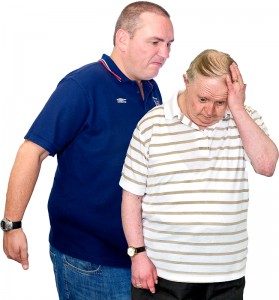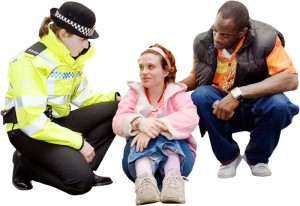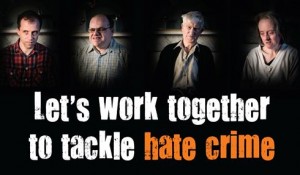
The British Crime Survey suggests that 9 out of ten disabled people have been the victims of disability hate crime, but Mencap’s Don’t Stand By report suggested that only around 3% of incidents are recorded by the police as hate crimes with only 1% leading to convictions.
The researchers in this three-year project set out to look at
- How many people with autism and learning disabilities were victimised
- The characteristics of victims and what happens to them
- Who the perpetrators are
- What barriers exist to reporting incidents and getting support
- What impact experiences and fears of victimisation has on wellbeing
- What the police find difficult in responding to reports
Methods
What they did was employ a mixed methods approach to gathering data, with four main strands
1. They carried out a review of calls made to the National Autistic Society and Autism London helplines related to victimisation experiences.
2. They ran seven focus groups with 31 people with learning disabilities and autism and four groups of 33 family and paid carers.
3. They ran a survey exploring victimisation experiences of people with learning disabilities and autism, which garnered 255 responses
4. They also carried out in depth interviews with 27 individuals, who volunteered, or who were invited to be involved by Kent Police
Results

46% of sample reported victimisation experiences
What they found was
46% of the whole sample reported victimisation experiences. They also found that people with victimisation experiences were more likely to be:
- younger
- those with mental health difficulties
- people with lower support needs
Whereas people without experiences were more likely to be in receipt of 24 hour support from staff
Nearly two thirds said it was teenagers who were the perpetrators and over half said the perpetrator as was known to them, (a friend, family member or neighbour)
As found in the Mencap investigation, nearly a fifth of victims had told no one. Only 38% had reported what had happened to the police.
Over 70% of those who had contact with the police were very or quite happy with the contact and said the police had stopped or tried to stop the bad things happening again.
16% of those who reported victimisation experiences said that life had changed for the worse as a result of those experiences.
Carers and families
Carers and families also reported significant impacts of victimisation experiences of people they supported. Those impacts were sometimes direct, in that carers themselves were also subject to victimisation, or indirect, in that they they had to manage and respond to the victimisation of the people they supported. Family carers reported being never “off duty” and living in fear of the phone ringing.
The police

Police face challenges in supporting victims, but most victims felt helped when issues reported
The police also identified a number of challenges in identifying and responding to disability hate crime including
- Communication issues with people who have autism and learning disabilities
- Getting evidence to investigate and prosecute and the time required for officers
The authors conclude that although most people with learning disabilities and autism live in the community with no experience of hate crime or victimization, there were significant numbers who had been victimised, with many people living in fear of victimization.
The most common response to such victimisation was that people changed their lives in some way to avoid the reoccurrence of incidents and that the impact on victims and their families or supporters can be severe and long lasting
They identify a number of issues impacting on practice, including:
- No clear, unambiguous definition of disability hate crime
- Low levels of knowledge and experience of learning disability and Autism for police officers, in particular around questioning and taking statements
- A reporting system that does not reliably capture level of vulnerability or whether or not people have a learning disability or autism
- Under-reporting – as people do not think what they are experiencing is serious enough to involve the police or believe it to be ‘what people with learning disability have to go through’
- Lack of preventative or proactive strategies
- Lack of vision and leadership
Recommendations
As a result of their findings, the authors make a number of recommendations including:
At a national level they recommend
- A refresh of the government hate crime action plan with specific expectations and timescales for simplifying hate crime definition, replacing the use of the word “hate”.
- The College of Policing should support the development of knowledge and skills in working with people with learning disability and autism
- The Department of Health should produce guidance for GPs around identifying physical and psychological effects of crime and harassment

Report recommends introduction of Response Charter and Common Referral System
At the local level, they suggest that Community Safety Partnerships work with Health and Wellbeing Boards and the third sector to:
- Introduce a Charter on how agencies will respond to incidents
- Support nominated lead officers to help raise awareness, training and disseminate best practice
- Develop a common referral system to police, housing, social and health care and Victim Support.
- Offer post incident and crisis support for victims
- Facilitate multi-agency panels to review cases, support and disposal options.
Link
Beadle Brown, J., Guest, C, Richardson, L., Malovic, A., Bradshaw, J and Himmerich, J. (2013) Living in Fear: Better Outcomes for people with learning disabilities and autism, Canterbury: Tizard Centre, University of Kent.

@WELDBlog – Almost half of adults with LD & #autism victimised in community cc @kevin_healey http://t.co/pRLMtE8Cxs
@autismcornwall @Kevin_Healey @WELDBlog Hats off to the Met Police for their contribution to this victimisation.
http://t.co/1Q7jZtIjPh
MT “@WELDBlog: Almost half of adults with with learning disabilities and autism face hate crime… http://t.co/Q6Jjf4UN0o“
RT @WELDBlog: Almost half of adults with learning disabilities & autism have been victims of hate crime http://t.co/oXdBicRZvU
Troubling report from the UK. I would guess that the figure are the same here. please note that “learning… http://t.co/pF32T3kB1L
Almost half of adults with learning disabilities and autism had been victimised in the community, via @WELDBlog http://t.co/hGtBOP1cqT
I agree with all the recommendations, and will add one to it: since the perpetrators were teen agers in many occasions, I would suggest the need to work on children in schools to teach them empathy, care and compassion for others, no matter what their situation may be. The concept of “The Earth is but one country and mankind its citizens” need to be at the forefront of every school subject and teacher. It will therefore need to be part of the curriculum in schools or we are most likely to fail.